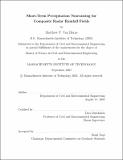Short-term precipitation nowcasting for composite radar rainfall fields
Author(s)
Van Horne, Matthew P. (Matthew Philip), 1980-
DownloadFull printable version (10.59Mb)
Other Contributors
Massachusetts Institute of Technology. Dept. of Civil and Environmental Engineering.
Advisor
Dara Entekhabi.
Terms of use
Metadata
Show full item recordAbstract
Precipitation nowcasting at very short lead times is a difficult and important earth science goal. The implications of nowcasting extend into aviation, flood forecasting and other areas. Using correlation analysis for the generation of velocity vectors to advect a composite radar rainfall field is the method of nowcasting utilized in this work. The MIT Lincoln Laboratory Growth and Decay Storm Tracker (GDST) is a correlation-based nowcasting algorithm that utilizes spatial filtering to eliminate the potentially adverse effects of transient, small-scale rainfall features in the correlation step. The GDST is used in this work to evaluate the benefits of image filtering as compared to a situation where the filtering is absent. The GDST generates a spatially variable velocity field for input rainfall field advection. Forecasts made using this enhancement are compared to forecasts made using a single velocity value for all input pixels in order to determine the benefits of allowing for differential motion within the storm envelope. The results from three storm cases show that image filtering provides improvement in forecast accuracy over an unfiltered case however, to fully determine any benefits from using spatially variable velocities requires more work. This work also documents the development and testing of a new correlation-based nowcasting algorithm. The Automated Precipitation Extrapolator (APEX) builds on advancements made over the past 40 years to provide highly accurate precipitation nowcasts. Initial testing shows that APEX-generated forecasts are more accurate than persistence forecasts, and are approximately as accurate as forecasts generated by the GDST or with a uniform advection method. Allowing for small errors in forecasted rainfall location, through an extended verification kernel, APEX-generated forecasts are visibly more accurate than GDST forecasts or uniform advection forecasts.
Description
Thesis (S.M.)--Massachusetts Institute of Technology, Dept. of Civil and Environmental Engineering, 2003. Includes bibliographical references (p. 75-80). This electronic version was submitted by the student author. The certified thesis is available in the Institute Archives and Special Collections.
Date issued
2003Department
Massachusetts Institute of Technology. Department of Civil and Environmental EngineeringPublisher
Massachusetts Institute of Technology
Keywords
Civil and Environmental Engineering.